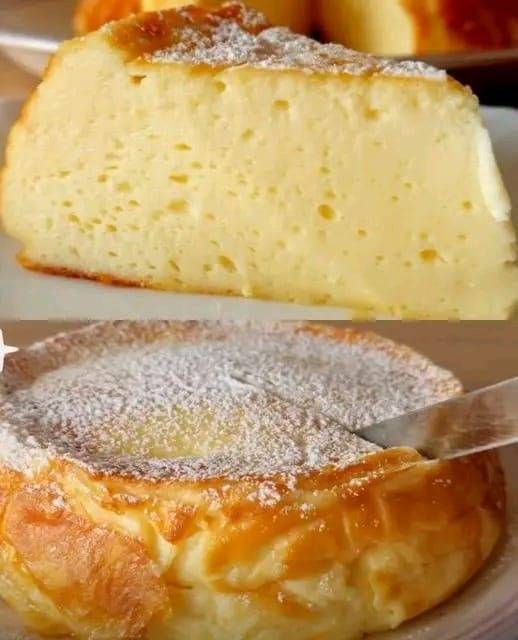- Preheat your oven to 320°F (160°C). Grease a 6-inch round cake pan and line the bottom and sides with parchment paper.
- Wrap the outside of the pan with aluminum foil to prevent water from leaking in during the water bath.
Step 2: Make the Cream Cheese Mixture
- In a heatproof bowl, combine the cream cheese, butter, and milk. Place the bowl over a pot of simmering water (double boiler) and stir until smooth and well combined. Remove from heat and let it cool slightly.
- Once cooled, whisk in the egg yolks, one at a time, until fully incorporated.
- Sift the all-purpose flour and cornstarch into the mixture and whisk until smooth. Add the vanilla extract and set aside.
Step 3: Make the Meringue
- In a clean, grease-free bowl, beat the egg whites using a hand mixer or stand mixer on medium speed until foamy.
- Add the cream of tartar (if using) and continue beating. Gradually add the sugar (for the meringue) in three additions, beating on medium-high speed until stiff peaks form.
Step 4: Combine the Mixtures
- Gently fold one-third of the meringue into the cream cheese batter using a spatula. Be careful not to deflate the mixture.
- Add the remaining meringue in two more additions, folding gently each time until no streaks remain. The batter should be light and airy.
Step 5: Bake the Cheesecake
- Pour the batter into the prepared cake pan. Tap the pan lightly on the counter to remove any air bubbles.
- Place the pan into a larger baking dish and pour hot water into the dish, creating a water bath (about 1 inch deep).
- Bake in the preheated oven for 50–60 minutes, or until the top is golden brown and the cake has risen slightly. Reduce the temperature to 300°F (150°C) and bake for an additional 10 minutes.
Step 6: Cool the Cheesecake
- Turn off the oven and leave the cheesecake inside with the door slightly ajar for 15–20 minutes to cool gradually. This prevents the cake from collapsing too quickly.
- Remove the cheesecake from the oven and water bath. Let it cool completely at room temperature before transferring it to the refrigerator.
- Chill for at least 2 hours or overnight for the best texture.
Step 7: Serve
- Remove the cheesecake from the pan and dust the top with powdered sugar if desired. Slice and serve chilled or at room temperature.
Tips for Success
- Room Temperature Ingredients: Make sure all ingredients, especially cream cheese and eggs, are at room temperature for easier mixing and a smoother batter.
- Meringue Tips: Avoid over-beating or under-beating the egg whites. Stiff peaks that hold their shape are crucial for the cake’s fluffiness.
- Water Bath: Ensure the aluminum foil around the pan is tightly sealed to prevent water from leaking into the cake.
- Patience in Cooling: Gradual cooling is essential to prevent the cake from deflating too much.
- Storage: Store leftover cheesecake in an airtight container in the refrigerator for up to 3 days.
Conclusion
Fluffy Japanese Cheesecake is a show-stopping dessert that’s sure to impress anyone who tries it. With its pillowy texture and delicate flavor, it’s a delightful departure from traditional cheesecakes. Though the process may seem a bit involved, following these steps will help you achieve a perfect, jiggly masterpiece. Enjoy every bite of this melt-in-your-mouth treat!
Happy baking!

